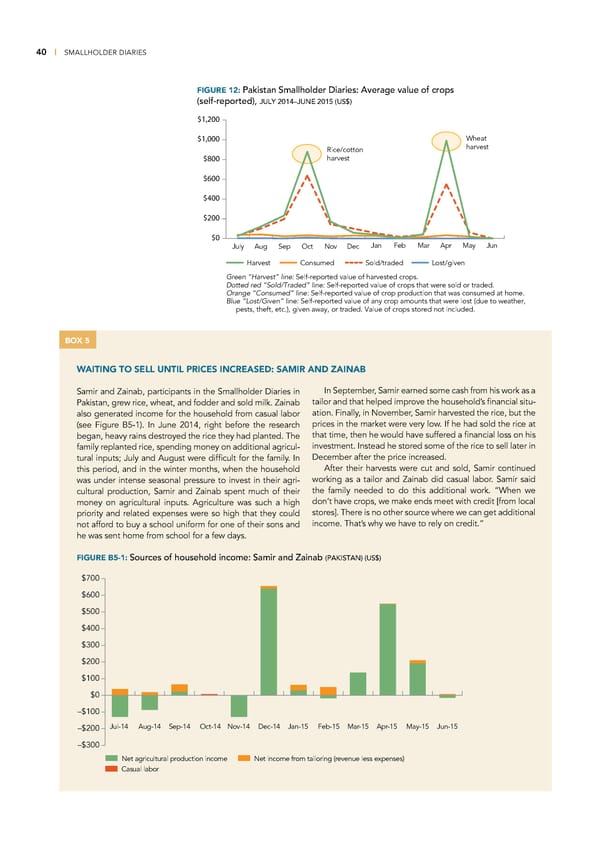40 | SMALLHOLDER DIARIES FIGURE 12: Pakistan Smallholder Diaries: Average value of crops (self-reported), JULY 2014–JUNE 2015 (US$) $1,200 $1,000 Wheat Rice/cotton harvest $800 harvest $600 $400 $200 $0 July Aug Sep Oct Nov Dec Jan Feb Mar Apr May Jun Harvest Consumed Sold/traded Lost/given Green “Harvest” line: Self-reported value of harvested crops. Dotted red “Sold/Traded” line: Self-reported value of crops that were sold or traded. Self-reported value of crop production that was consumed at home. Orange “Consumed” line: Blue “Lost/Given” line: Self-reported value of any crop amounts that were lost (due to weather, pests, theft, etc.), given away, or traded. Value of crops stored not included. BOX 5 WAITING TO SELL UNTIL PRICES INCREASED: SAMIR AND ZAINAB Samir and Zainab, participants in the Smallholder Diaries in In September, Samir earned some cash from his work as a Pakistan, grew rice, wheat, and fodder and sold milk. Zainab tailor and that helped improve the household’s financial situ- also generated income for the household from casual labor ation. Finally, in November, Samir harvested the rice, but the (see Figure B5-1). In June 2014, right before the research prices in the market were very low. If he had sold the rice at began, heavy rains destroyed the rice they had planted. The that time, then he would have suffered a financial loss on his family replanted rice, spending money on additional agricul- investment. Instead he stored some of the rice to sell later in tural inputs; July and August were difficult for the family. In December after the price increased. this period, and in the winter months, when the household After their harvests were cut and sold, Samir continued was under intense seasonal pressure to invest in their agri- working as a tailor and Zainab did casual labor. Samir said cultural production, Samir and Zainab spent much of their the family needed to do this additional work. “When we money on agricultural inputs. Agriculture was such a high don’t have crops, we make ends meet with credit [from local priority and related expenses were so high that they could stores]. There is no other source where we can get additional not afford to buy a school uniform for one of their sons and income. That’s why we have to rely on credit.” he was sent home from school for a few days. FIGURE B5-1: Sources of household income: Samir and Zainab (PAKISTAN) (US$) $700 $600 $500 $400 $300 $200 $100 $0 –$100 –$200 Jul-14 Aug-14 Sep-14 Oct-14 Nov-14 Dec-14 Jan-15 Feb-15 Mar-15 Apr-15May-15Jun-15 –$300 Net agricultural production income Net income from tailoring (revenue less expenses) Casual labor
 Financial Diaries with Smallholder Families Page 53 Page 55
Financial Diaries with Smallholder Families Page 53 Page 55